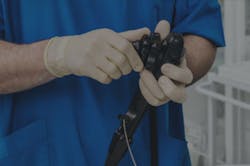Type “duodenoscope” into the Google search engine and within 0.3 seconds nearly 112,000 results pop up.
The Food and Drug Administration dominate the first two links with the federal agency’s reports on the bacterial infections associated with reprocessed duodenoscopes during the last two years.
During this time the media extensively covered the issue, the Centers for Disease Control and Prevention also weighed in, lawsuits were filed and one of the manufacturers initially updated and validated reprocessing instructions before issuing a massive voluntary recall of its device earlier this year to redesign it.
Seemingly lost amid the hue and cry, the blame game and the finger pointing as to who should be held responsible were constructive discussions around potential solutions to the duodenoscope problem.
Chief among the potential solutions raised by Healthcare Purchasing News in last year’s Endoscope Care Guide was redesigning the device, improving the manufacturer instructions-for-use or switching to single-use only versions of the device, the last of which HPN learned was the most expensive option upfront.
Redesign device, not IFUs
Certainly, a device redesign is needed, according to sterile processing experts who also question whether that decision represents workable solution that doesn’t unleash a domino effect.
“Redesigning the duodenoscope with cleaning and disinfection in mind is needed,” said Donna Swenson, President and CEO, Sterile Processing Quality Services Inc., Stickney, IL, and a former hospital sterile processing director. “The current design is very difficult to clean, and as we have seen, can cause patients to get life-threatening infections. It may be possible to design a duodenoscope that can be disassembled for cleaning and then reassembled. This also has its issues though. The redesign will no doubt cost money in terms of design and testing before a new design is developed. This cost will make it more expensive for the healthcare facility to buy this device, and it’s already quite expensive. Disassembly and reassembly of the device will require increased processing time, which might create a need for additional inventory to ensure that a new device is available when needed. The technicians who reprocess these devices will need additional training and might need skills that are not currently needed. This could result in higher wages being needed to ensure that the technicians have the appropriate skills needed.”
Even so, the clinical advantages are in support of patient safety, according to Jean Sargent, Principal, Sargent Healthcare Strategies, and a former hospital sterile processing executive.
“Improvements on the technology available today is necessary and expected,” she said. “The financial and operation perspectives are not negative, but a reality. The financial aspect involves return on investment and marketing strategies for the provider. The providers do not have the financial ability to say yes to every new or updated technology when it hits the market. The ROI must take into consideration the number of uses per month/year, the availability to meet the IFU requirements, education and training for physicians, clinicians, SPD and others.”
While one manufacturer worked to update and validate its IFUs for the device, it’s really not enough, Swenson noted.
“Merely improving duodenoscope IFUs and retraining SPD professionals is not addressing the root cause of this problem,” she said. “This will help but I don’t see this as a final solution. The current design is very difficult to clean even when the IFU for cleaning is followed. In addition to reinforcing the current IFU we need to add a step for verifying the cleaning process. There are a number of test devices that can be used after the scope has been cleaned to determine if there is still soil present on the device. These need to be used each time that a scope is cleaned before going on to the disinfection or sterilization step. Long term though, we need to make the cleaning process easier to follow and get consistent results. This will require changing the design of the scope to make it easier to clean.”
Single-use option
Disposable alternatives may be just what the doctor ordered.
“Endoscope technology is rapidly evolving as the industry works to address the complexity and challenges that exist today around making sure that endoscopes are high-level disinfected or sterilized in the right way every time,” said Rob Cripe, Vice President, North American Sales and Marketing, Integrated Endoscopy, Rancho Santa Margarita, CA. “As single-use endoscopes become available for more types of procedures, facilities will have the flexibility to use them as front-line scopes for select high-risk patients and/or as a backup for all procedures. Single-use scopes with highly polished glass lenses also ensure first time image quality for every procedure. Single-use endoscopes that provide the assurance of image quality, along with the assurance of sterility, will have an important role to play in the future in endoscopic surgery.”
John Cifarelli, Chief Commercial Officer, Invendo Medical Inc., Garden City, NY, cited government studies that logically justify single-use alternatives.
“According to the CDC, contaminated endoscopes have been linked to more healthcare-associated infection outbreaks than any other medical device,” Cifarelli noted. “New studies also continue to be published that show the persistence of contamination of all GI endoscopes, including gastroscopes and colonoscopes, even after being disinfected according to recent cleaning guidelines. Most important, high-level disinfection does not offer the higher safety margin that sterilization does. How can your institutions’ endoscope reprocessing staffs be expected to provide their facilities with 100 percent clean and germ-free endoscopes when these new studies have shown that this is nearly impossible?”
Cifarelli acknowledged that endoscopes serve an important purpose in the medical community to help maintain optimal health for patients as well as diagnose and treat diseases.
“But endoscopes are also extremely difficult to clean properly due to their complex design and the inevitable contamination from the GI tract,” he said. “To complicate things further, the material makeup of endoscopes does not allow for routine heat sterilization. We need a better solution.
“When a medical device is just too difficult to clean and disinfect properly and adequately, it places medical staff and patients at risk, time and time again,” he continued. “The ideal solution is a single-use endoscope that is pre-sterilized.” His company launched the first of a growing line of single-use endoscopes for a variety of minimally invasive surgical procedures.
“Although the recently published new guidelines from AAMI, SGNA and AORN are vast improvements for cleaning and disinfecting endoscopes, they still aren’t enough to reduce the risk of cross-contamination significantly,” Cifarelli noted. “One needs to ask: Are these new guidelines expecting too much of our reprocessing staff?” Is it reasonable to expect our reprocessing staff to adhere to each and every arduous step of these new guidelines for 10 or 20 or even 25 scopes per day and continue to place themselves at risk from exposure to potentially harmful cleaning chemicals?”
Cifarelli recalled attending an endoscope reprocessing course last spring at IAHCSMM where he “personally concluded it is nearly impossible.
“Instead, I believe that we should take steps to ensure our reprocessing staffs have the opportunity to be successful at what they do and protect their facilities and patients,” he said. “Wouldn’t it make more sense to limit the number of endoscopes a staff member would need to reprocess in a given day, so he or she can ensure 100 percent compliance? Wouldn’t it also make sense to limit the amount of medical trash required to properly clean and disinfect just one endoscope? We think so. Sterile and single-use endoscopes can fit seamlessly into any established endoscopy department and at the same time reduce the onerous burden on the reprocessing staff and the amount of medical waste.”
Cifarelli also called for the Spaulding Classification system be re-examined. “Although this system offered excellent insight and guidance, much has changed in the 50+ years since its introduction, and we need to reevaluate our overall approach to medical devices and infection control,” he added.
“Currently, endoscopes are classified as semi-critical devices, which should be reprocessed free from all microorganisms,” Cifarelli said. “However, again, recent studies indicate that this is not entirely possible. Two key paradigm shifts have occurred in the last 50 years: Endoscopes today are significantly more therapeutic in addition to diagnostic than they were 50 years ago, yet manufacturers have not updated material composition to permit heat sterilization as an option, and given the number of new superbug outbreaks, sterilization should be required for all endoscopes, and should no longer be a conditional protocol.
“It is the 21st century and time to have our health regulations become more reflective of and responsive to the current risks we face,” he added.
Not so fast
While single-use only duodenoscopes may be garnering confidence and gaining traction with some in the sterile processing world, they generate other concerns among sterile processing experts.
“Single-use only duodenoscopes have the advantage of not needing to be cleaned and disinfected, thus avoiding the problem of how difficult it is to clean this device,” Swenson said. “However, single-sue devices also create other issues. These are biohazardous waste that will need to be disposed of. Disposal of biohazardous waste is a big concern. Many of the materials that are used in single-use devices cannot be incinerated and instead end up in landfills. This creates a problem of potential contamination of the ground and ground drinking water sources. I think that switching to a single-use device needs to be carefully looked at to determine if this approach is cost effective and environmentally acceptable.”
Sargent echoed similar sentiments.
“The cost of purchasing the single-use product along with the disposal and filling of the landfills are thoughts that must be taken seriously prior to making this paradigm shift,” she said. “As one manufacturer indicates there are 3,400 scopes of one type in use, and the volume of the procedures performed across country, indicates a significant impact on cost per unit as well as product entering the landfills. There may be opportunity for a partial disposable scope.”
About the Author
Rick Dana Barlow
Senior Editor
Rick Dana Barlow is Senior Editor for Healthcare Purchasing News, an Endeavor Business Media publication. He can be reached at [email protected].




